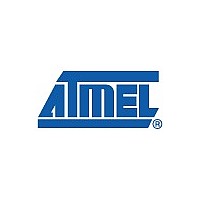ATtiny24 Atmel Corporation, ATtiny24 Datasheet - Page 164

ATtiny24
Manufacturer Part Number
ATtiny24
Description
Manufacturer
Atmel Corporation
Specifications of ATtiny24
Flash (kbytes)
2 Kbytes
Pin Count
14
Max. Operating Frequency
20 MHz
Cpu
8-bit AVR
# Of Touch Channels
4
Hardware Qtouch Acquisition
No
Max I/o Pins
12
Ext Interrupts
12
Usb Speed
No
Usb Interface
No
Spi
1
Twi (i2c)
1
Graphic Lcd
No
Video Decoder
No
Camera Interface
No
Adc Channels
8
Adc Resolution (bits)
10
Adc Speed (ksps)
15
Analog Comparators
1
Resistive Touch Screen
No
Temp. Sensor
Yes
Crypto Engine
No
Sram (kbytes)
0.12
Eeprom (bytes)
128
Self Program Memory
YES
Dram Memory
No
Nand Interface
No
Picopower
No
Temp. Range (deg C)
-40 to 85
I/o Supply Class
1.8 to 5.5
Operating Voltage (vcc)
1.8 to 5.5
Fpu
No
Mpu / Mmu
no / no
Timers
2
Output Compare Channels
4
Input Capture Channels
1
Pwm Channels
4
32khz Rtc
No
Calibrated Rc Oscillator
Yes
Available stocks
Company
Part Number
Manufacturer
Quantity
Price
Company:
Part Number:
ATtiny24-15SSZ
Manufacturer:
ATMEL
Quantity:
349
Part Number:
ATtiny24-15SSZ
Manufacturer:
ATTINY
Quantity:
20 000
Part Number:
ATtiny24-20MU
Manufacturer:
AVNET
Quantity:
20 000
Company:
Part Number:
ATtiny24-20SSU
Manufacturer:
ATMEL
Quantity:
5 000
Part Number:
ATtiny24-20SSU
Manufacturer:
ATMEL/爱特梅尔
Quantity:
20 000
Company:
Part Number:
ATtiny24-20SSUR
Manufacturer:
ATMEL
Quantity:
6 000
Company:
Part Number:
ATtiny24A-CCU
Manufacturer:
ATMEL
Quantity:
1 001
Company:
Part Number:
ATtiny24A-MU
Manufacturer:
ATMEL
Quantity:
2 710
Part Number:
ATtiny24A-MU
Manufacturer:
ATMEL/爱特梅尔
Quantity:
20 000
Part Number:
ATtiny24A-SSU
Manufacturer:
MICROCHIP/微芯
Quantity:
20 000
19.5.1
164
ATtiny24/44/84
Serial Programming Algorithm
instruction. The Chip Erase operation turns the content of every memory location in both the
Program and EEPROM arrays into 0xFF.
Depending on CKSEL Fuses, a valid clock must be present. The minimum low and high periods
for the serial clock (SCK) input are defined as follows:
When writing serial data to the ATtiny24/44/84, data is clocked on the rising edge of SCK. When
reading, data is clocked on the falling edge of SCK. See
details.
To program and verify the ATtiny24/44/84 in the Serial Programming mode, the following
sequence is recommended (see four byte instruction formats in
• Low:> 2 CPU clock cycles for f
• High:> 2 CPU clock cycles for f
1. Power-up sequence:
2. Wait for at least 20 ms and enable serial programming by sending the Programming
3. The serial programming instructions will not work if the communication is out of syn-
4. The Flash is programmed one page at a time. The memory page is loaded one byte at
5. A: The EEPROM array is programmed one byte at a time by supplying the address and
Apply power between V
tems, the programmer can not guarantee that SCK is held low during power-up. In this
case, RESET must be given a positive pulse after SCK has been set to '0'. The duration
of the pulse must be at least t
20-4 on page
Enable serial instruction to pin MOSI.
chronization. When in sync. the second byte (0x53), will echo back when issuing the
third byte of the Programming Enable instruction. Whether the echo is correct or not, all
four bytes of the instruction must be transmitted. If the 0x53 did not echo back, give
RESET a positive pulse and issue a new Programming Enable command.
a time by supplying the 5 LSB of the address and data together with the Load Program
memory Page instruction. To ensure correct loading of the page, the data low byte must
be loaded before data high byte is applied for a given address. The Program memory
Page is stored by loading the Write Program memory Page instruction with the 3 MSB
of the address. If polling (RDY/BSY) is not used, the user must wait at least t
before issuing the next page. (See
gramming interface before the Flash write operation completes can result in incorrect
programming.
data together with the appropriate Write instruction. An EEPROM memory location is
first automatically erased before new data is written. If polling (RDY/BSY) is not used,
the user must wait at least t
page
grammed.
B: The EEPROM array is programmed one page at a time. The Memory page is loaded
one byte at a time by supplying the 2 LSB of the address and data together with the
Load EEPROM Memory Page instruction. The EEPROM Memory Page is stored by
loading the Write EEPROM Memory Page Instruction with the 4 MSB of the address.
When using EEPROM page access only byte locations loaded with the Load EEPROM
Memory Page instruction is altered. The remaining locations remain unchanged. If poll-
ing (RDY/BSY) is not used, the used must wait at least t
165.) In a chip erased device, no 0xFFs in the data file(s) need to be pro-
177) plus two CPU clock cycles.
CC
and GND while RESET and SCK are set to “0”. In some sys-
WD_EEPROM
ck
ck
RST
< 12 MHz, 3 CPU clock cycles for f
< 12 MHz, 3 CPU clock cycles for f
(the minimum pulse width on RESET pin, see
Table 19-11 on page
before issuing the next byte. (See
Figure 20-4
WD_EEPROM
165.) Accessing the serial pro-
Table
and
19-12):
ck
ck
before issuing the
>= 12 MHz
>= 12 MHz
Figure 20-5
Table 19-11 on
WD_FLASH
8006K–AVR–10/10
Table
for timing












